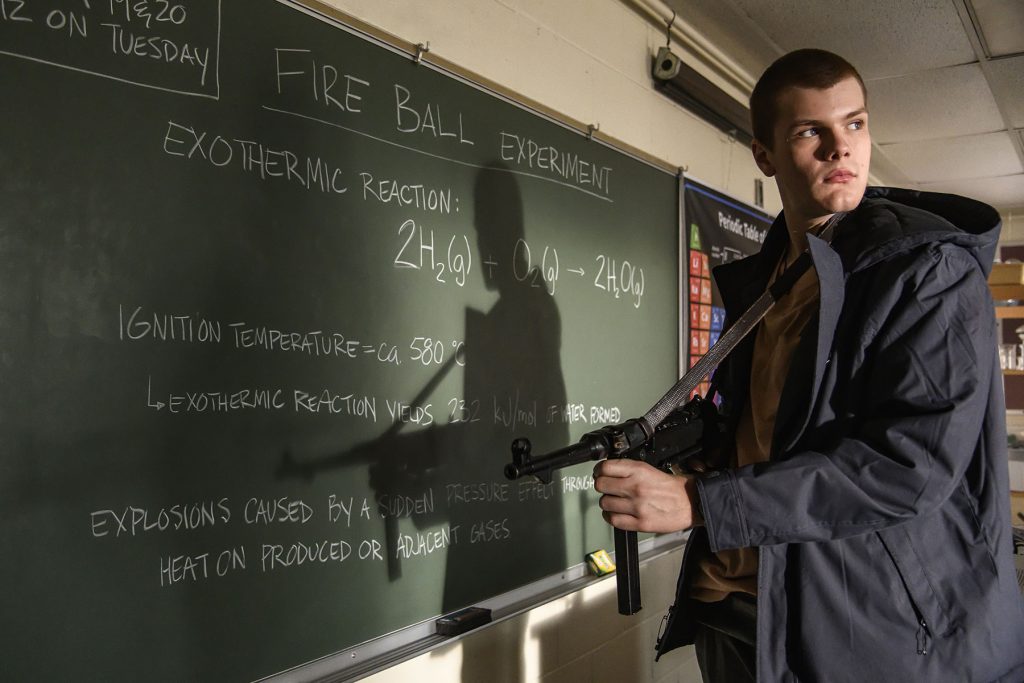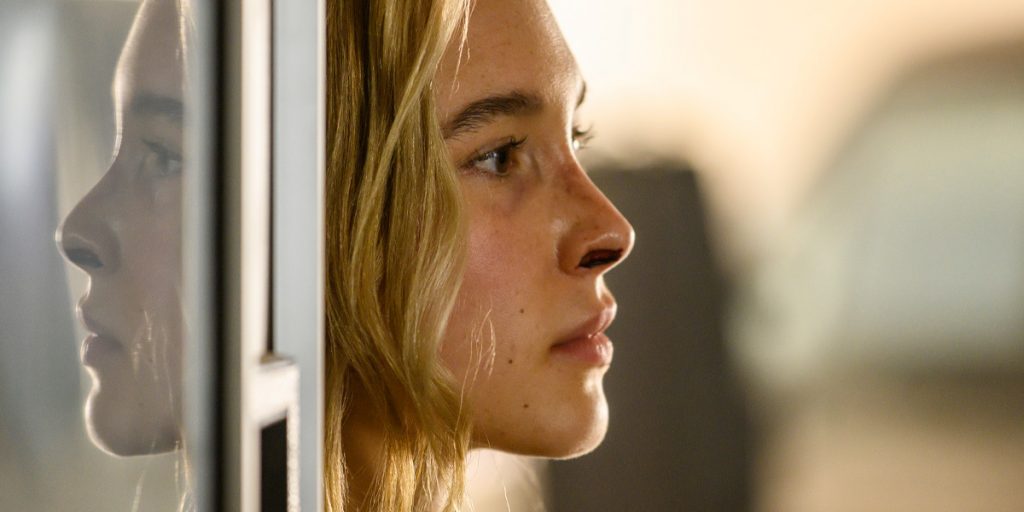Run Hide Fight ignores its supposed “neutrality” and offers harmful, unoriginal arguments to the gun violence discourse in an already exploitative premise.
One of the most egregious yet intriguing films in recent years, Run Hide Fight brings the familiar “Die Hard in a…” action thriller formula into unprecedented, reckless territory: inside a school shooting. Writer and director Kyle Rankin’s film centers on Zoe (Isabel May), a stoic high school senior who leaps into action when four armed students violently attack her school. Equipped with the skills her father taught her, Zoe narrowly evades the shooters and decides to risk her life and fight back to save the trapped victims. Beyond its already exploitative premise of using the setting of a school shooting for an action thriller, Run Hide Fight is particularly troubling for its sanitized presentation, tired arguments, and clear absence of meaningful conversation it claims to pose.
In his director’s statement, Rankin explains that he wrote Run Hide Fight “to deal with the fear and helplessness [he] felt (and still feel) whenever there’s a mass shooting.” His intent for the film “wasn’t to exploit anyone’s pain, but rather to potentially kickstart respectful conversations about guns in America,” explaining that “the final film purposely leans neither pro- nor anti-gun,” hoping “that it might facilitate more dialogue than division.” It’s funny to hear that those were his intentions, because Run Hide Fight does the complete opposite of that, taking a strong pro-gun stance while engaging in obtuse, myopic conversation.
While it does condemn mass shootings, it reduces malevolent gun violence to the individual motivations of the shooters and never bothers to interrogate topics of gun culture and the rampant amount of guns in America, not to mention how easy it is to gain access to them. Most irritating, and predictable too, is that it repeats the tired pro-gun talking point that the only way to stop a “bad guy with a gun” is a “good guy with a gun.” While Zoe’s ingenuity and quick instincts save her and her classmates’ lives, guns ultimately save the day, especially in a pivotal scene towards the end. Guns aren’t really the problem, Run Hide Fight suggests, it’s just who’s using them.

Rankin adds that, while “other films have focused more on the perpetrators, in an attempt to delve into the ‘why’ of what they did,” Run Hide Fight is more interested in what might happen “if we suddenly found ourselves caught up in the horror of a shooting.” He remarks that “we hope we’d be the quick-thinking one, the brave one, maybe the one to prevent it from escalating or happening at all”, and his protagonist “Zoe puts us there and makes us consider what we’d do and who we might be.” Run Hide Fight wisely avoids focusing too much on the shooters’ motivations, which come across as messy, complicated, and even confused. It’s easy to see how this film could have gotten too caught up in that “why” and tried to moralize its messaging, but Rankin instead goes for a fresh perspective by putting us in the moment to ask ourselves how we would act in a school shooting. Except that highlights one of this film’s most glaring problems: what purpose does a film that immerses us into a mass shooting serve?
We don’t need a cinematic depiction of a school shooting to understand how terrifying these events truly are—news coverage and headlines are already troubling enough, giving us the blunt details of horrific acts of violence committed against young victims in spaces of safety and learning. Run Hide Fight even fails at immersing us into the experience of a school shooting since it feels too sanitized and artificial to really shock and terrify. It’s a violent and vicious film, but it’s very much the Hollywood version of a mass shooting where it’s bloody and gruesome—but not too bloody and gruesome. For such a provocative film, its cinematic presentation strangely feels tame and lacks the convincing immersion it’s aiming for, instead serving as the vehicle for its “lone hero fights the shooters” fantasy.
Run Hide Fight is egregious on many levels. It makes no innovative or compelling arguments, instead retreating to the same tired, predictable talking points that always appear in the same cycle of discourse around guns after every mass shooting. Featuring a bizarrely sanitized presentation to an otherwise provocative and controversial premise, it doesn’t challenge us, it doesn’t shock us, and worst of all, it offers no sense of catharsis. It’s often difficult to find that catharsis in the wake of traumatic, real-world events, and that’s where art can step in to provide that emotional release. It’s a relentlessly grim and nihilistic film with no interest in its audience, offering no space to reflect and no place to emotionally exit. Especially in light of two recent mass shootings that happened within days of each other, as well as the more than 100 other mass shootings in America that have happened this year, Run Hide Fight becomes even more hollow, repulsive, and reckless with its tactless storytelling.

